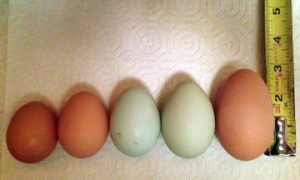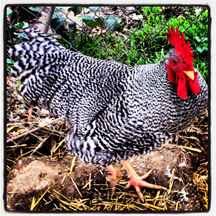Hopefully you’re up to speed with all of my chicken posts so you can feel my pain with this one. Just when we thought we’d dealt with just about every imaginable problem with our chickens…
The story unfolds at approx. 7:30 p.m. on Friday, June 22, 2012. Super excited about relaxing with some wine and a movie after a tough week (I’m 40, what can I say). The chickens were outside of their coop run foraging in the yard with our two amazing Border Collies keeping a watchful eye over the flock—or so we thought. I had to run out for a few minutes so I left the girls out in the yard with the dogs. Trust me, the dogs wouldn’t hurt a fly and we’d done this before. They might herd a fly, but that’s another story.
Anyways, I arrive home about 30 minutes later and find one of the hens in the corner of the yard slumped down in the grass not moving. Oh, no!! Full-on panic mode ensues. I run to her and find a huge patch of skin missing from her back and puncture wounds in her bruised neck (pic from that night is below). I think she is dead but she opens her eyes as I kneel down beside her. Now I’m thinking her neck is broken and I will have to put her out of her misery, by myself—husband’s not home. Could this get any worse?? I check her over and she becomes more alert but she’s definitely in shock. I ever so gently move her neck and it doesn’t seem to be broken, so right away I’m thinking I can fix this. I run inside, grab a bowl of warm water, sterile pads and antiseptic spray. I tend to her the best that I can and find it strange that there’s not blood anywhere but her feathers are wet. After thinking about this, we concluded that a hawk that had been lingering as of late (a juvenile Cooper’s hawk), which I completely forgot about (I’m a HORRIBLE chicken mom!), must have grabbed her by the back and neck as the puncture wounds were consistent with talons (don’t I sound like a CSI investigator?) but that the hen was too heavy and the hawk ended up leaving with her back skin only, and as she crashed back down to earth the dogs raced to her and licked her wounds. It’s the only thing that made sense.
After washing her wounds, covering them with Neosporin and a gauze pad, and giving her lots of antibiotic water by hand, I did some speedy Internet research and concluded I had done all I could for the night. I had to separate her from the flock until she healed, if she healed, so her new home became a dog kennel during the day, and an empty table saw box inserted into the dog kennel at night (see pics).
The next day, I thankfully found her still alive in the box. I re-washed her wounds with antiseptic, covered them again with Neosporin and a fresh gauze pad. I gave her antibiotic water by hand and raced to the pharmacy. The pharmacist, bless his heart, heard my tale and suggested I also treat her wounds with iodine, so I bought some and raced back home. That afternoon, I saw some folks from the local raptor rescue center and told them what happened. They suggested I see a vet as she might need stitches, so I actually took my hen to the vet the next day. It was pretty funny, but $60 later I was told there was nothing the vet could do. The wound was too large to stitch but he did confirm that all the steps I had taken thus far were spot-on, then he gave me some antibiotic powder and some pills (again with the chicken pills??).
So here’s the routine that was followed twice daily for about three weeks:
- Wash wound with antiseptic.
- Apply iodine.
- Apply antibiotic powder (saw it at the feed store later, so you might want to buy a bottle just in case. It comes in a shaker container and is small, probably just a few ounces.)
- Cover gauze pad with Vaseline to prevent it from sticking to the wound.
- Apply gauze to wound.
- Administer oral antibiotic (i.e., shove pill as far down chicken’s throat as you can)
Since I could not cover her neck wounds, I had to be diligent about washing and keeping them clean. Her neck healed first and her back started to re-grow the skin—I couldn’t believe that I was actually pulling this off! I had to be sure to trim the feathers away from the wound to keep the infection down and prevent feathers from becoming caught in the re-grown skin/scab. Once the wound had healed over, the older scabs would lift off revealing new skin and feathers started to re-grow. It was truly a miracle! Once her feathers had covered the healed wound, I was able to let her back in with the flock. She was picked on a bit at first and is very fearful when a hawk calls out overhead, but she is laying again and still re-growing her missing feathers.















